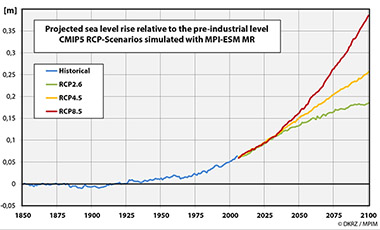The height of the sea surface is influenced by various processes: short run fluctuations due to the weather and tides, as well as long run changes caused by variability in the climate and earth system. Essentially, the long run factors are as follows:
- Changes in the water volume due to changing temperatures (steric expansion)
- Changes in global ocean currents (dynamic alignment)
- Expansion and reduction of the large ice caps (Greenland, Antarctic) and mountain glaciers (eustatic changes)
- Changes in ocean basin capacities: Rising/sinking of the Earth’s crust (tectonic changes)
The MPI-ESM simulations presented here take into account the steric and dynamic changes, but exclude the eustatic and tectonic changes. The figures below show the global mean sea level rise due to the change in water volume for the calculated past and different scenarios.
 |
 |
|
Simulated Sea Level Rise for 1850 - 2100 (MPI-ESM MR) |
Simulated Sea Level Rise for 1850 - 2300 (MPI-ESM LR) |
Above left is the graph of the sea level changes from 1850-2100 as calculated by the higher resolution MR model. Depending on the scenario, the simulation shows that compared to the pre-industrial values, a rise of between 20 and 40cm is to be expected by 2100. The figure at right shows the possible values calculated up to 2300 using the LR model simulations. One can clearly deduce that the sea level will rise over the next centuries, and, depending on the scenario, reach an average of between 0.3 and 1.6 meters by 2300 as compared to the pre-industrial situation.
The projected sea level change in the 21st century is comparatively smaller in higher latitudes than in the arctic, where the sea level is expected to rise significantly due to the increased influx of fresh water. Shifts in ocean circulation will likewise contribute to an inhomogenous rise in the sea level, as compared to the global mean, for example, in the Atlantic.
In the RCP8.5 simulation, the global mean sea level is expected to rise by nearly 40 cm by 2100 due to an increase in water temperatures. Regionally however, the projections show sea level rises of over 1 m. For the RCP2.6 scenario on the other hand, the simulation shows that water temperature increases contribute to a global mean rise of fewer than 20 cm by 2100.


